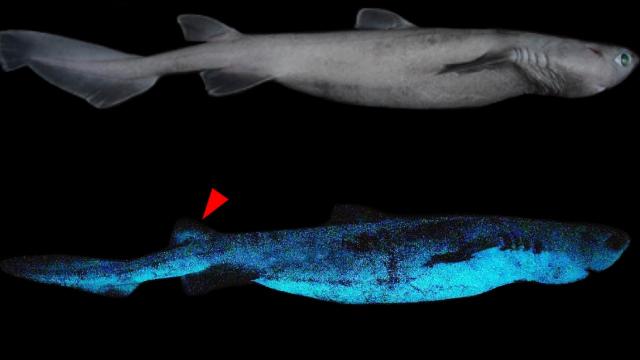All of a sudden lots of animals seem to glow. We’ve had bioluminescent wombats, bioluminescent platypuses, and now we have bioluminescent sharks. No, this isn’t a promo for the next Avatar film. Glow in the dark sharks really are a thing.
Researchers from the Université Catholique de Louvain in Belgium and NIWA in New Zealand conducted a survey of shark specimens off the coast of eastern New Zealand. The shark specimens captured were photographed in dim daylight and dark conditions and researchers also took tissue samples.
The species discovered to glow include the kitefin shark (Dalatias licha), the black belly lantern shark (Etmopterus lucifer), and the southern lantern shark (Etmopterus granulosus). The kitefin shark gets a special mention as the largest known luminous vertebrate.
The scientists note that shark bioluminescence isn’t a new find, however, this is the first time these glowing sharks have been caught on camera.
Why do these sharks glow?

Luminescence is achieved via thousands of photophores located within the epidermis, the report describes. Researchers found that the cause of shark luminescence was structurally similar across all three species.
These three species of shark all inhabit the mesopelagic zone, which ranges from 200-1000m deep. Known as the twilight zone this region of the sea provides no place to hide, hence the sharks need glowing camouflage or counter illumination.
The study found that bioluminescence in the two lantern sharks lines up with previous studies into the species. They both have glowing skin on their undersides that is assumed to be used for counter illumination, which helps them camouflage from predators beneath them.
The kitefin shark provided some new discoveries, such as the first shark to display a full luminous dorsal fin.
Scientists posit two reasons that the kitefin shark might make use of its bioluminescence. The shark is both a slower swimmer and feeds on the ocean floor. Therefore, it believed it may use its glow to light its way as it searches for prey or as a counter illumination camouflage technique to stealthily approach prey, striking at the last moment.
However, the reason for its glowing dorsal fin remains a mystery.
Scientists said that this research has helped to understand just how important bioluminescence is for deep-sea environments.
